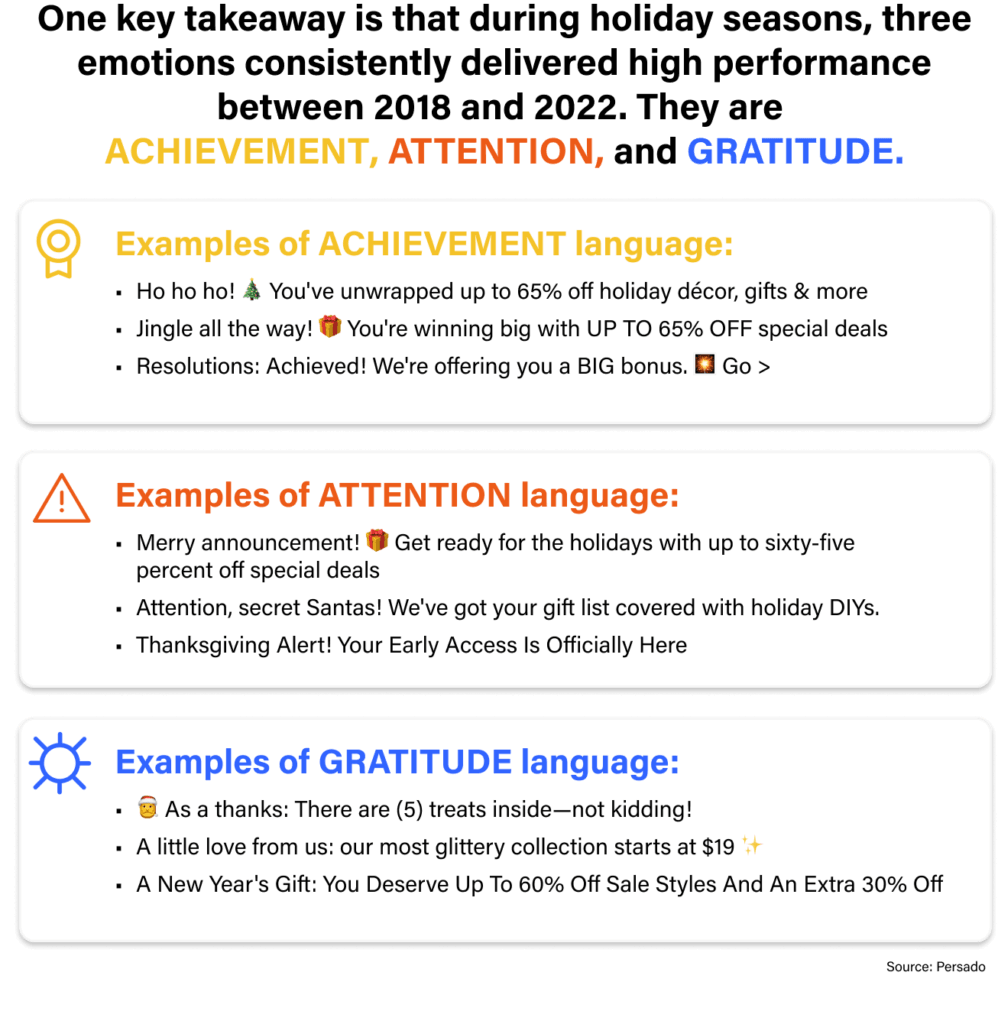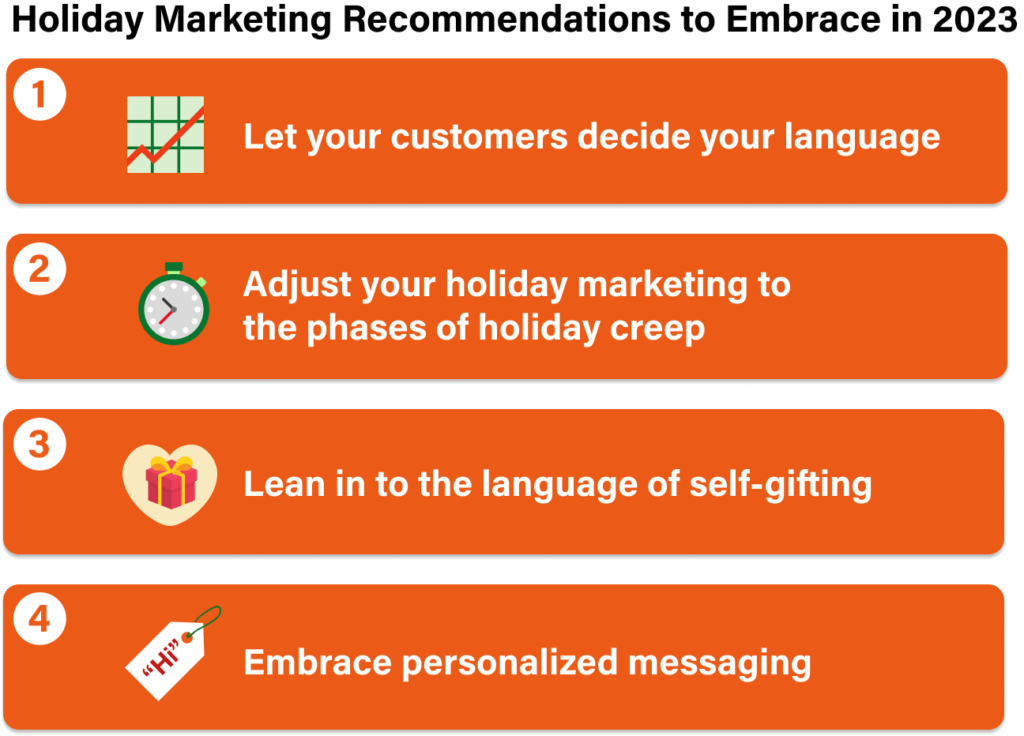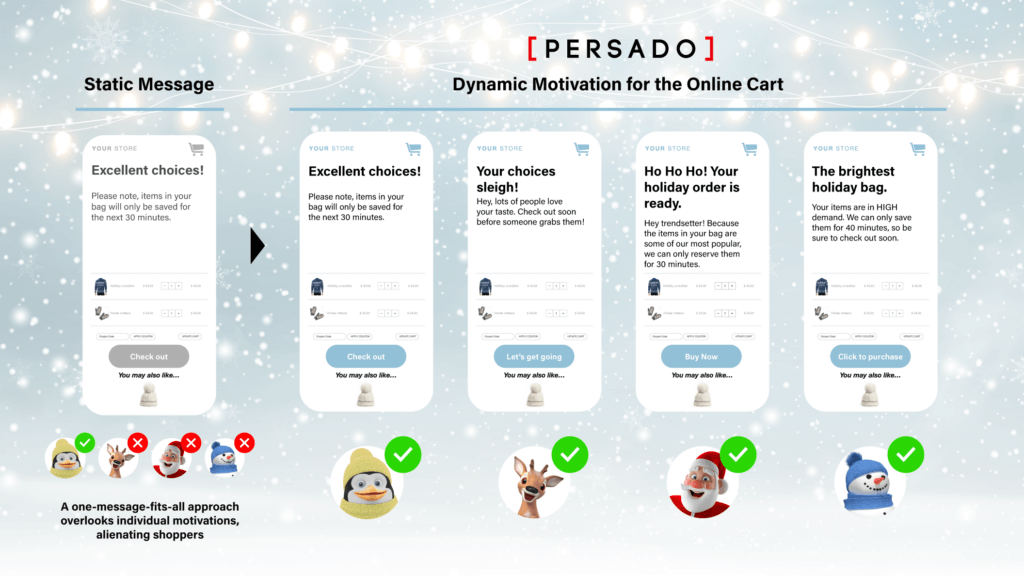October 4, 2023
The 2023 Persado Holiday Marketing Guide: How to Optimize Campaign Performance in the Era of Holiday Creep
By Lisa Spira

Is this the year that end-of-year holiday shopping returns to “normal”? By normal, we mean the predictable post-Thanksgiving kick off followed by weeks of robust spending on gifts, food, and decorations. Persado’s prediction? No—“normal” doesn’t exist anymore. Economic and social changes that were already underway before the pandemic have permanently transformed the holiday shopping season for the long term. The 2023 holiday season, the first one that’s officially post-pandemic, will be longer and have more diverse and less predictable spending than the ghosts of holidays past. That requires an update to your holiday marketing.
That doesn’t mean that the major retail shopping holidays like Black Friday and Cyber Monday 2023 won’t make the year for retail. It will for some. It just doesn’t tell the whole story anymore.
Digital marketers across retail, travel, and other sectors that see a holiday boost, must adapt their approach to optimize not only their holiday marketing campaigns, but every campaign they run in the fourth quarter of the year. We explore how by outlining the economic and social changes that have taken place, why they matter, and how brands can use them to their advantage with the help of Generative AI.
The changed consumer economics of end-of-year shopping
Ask most people over the age of 35 about their childhood traditions during the holidays and you are most likely to hear a more modest story than what happens today. Whether for Christmas or Hanukkah, most kids growing up in the late-1980s or early 1990s remember getting one significant gift (relative to their household means) and maybe some smaller trinkets or treats. The adults, for their part, often organized a Secret Santa or gift exchange to keep spending under control. That’s a far cry from the “out of hand” holiday spending people talk about today.
That perception of increased spending is not just anecdotal. Data on household spending from the US Census Bureau, analyzed by the National Retail Federation, show that the total dollars spent during the holiday season more than doubled between 2002 and 2021, from $416.4 billion to $889.3 billion. When inflation-adjusted to 2021 numbers, the results show that US consumers collectively spent 130% more during the holiday season in 2021 than they did 20 years ago. Growth in the adult population accounts for only some of that.
Spending and income—a holiday shopping disconnect
Increased disposable income could explain increases in holiday spending if it weren’t for the fact that US incomes have risen only modestly in the past 20 years. The median US household income in 2021 was $70,784, according to the US Census Bureau. That is just 11% higher than the 2001 median of $64,047. At the same time, spending on essentials like housing and healthcare absorbed a larger share of people’s income, leaving less disposable income than before.
Less disposable income gives US households limited options for how they can spend more on holiday gifts. One way is to plan for it. If you know you’re going to spend a lot more money at the end of the year, you compensate by spending less earlier in the year and/or less in October and November.
Another way is to spread out your spending by starting earlier. Say hello to “holiday creep.”
What is holiday creep?
We see the trend of spreading out spending play out in the phenomenon known as “Christmas creep.” Or more inclusively, “holiday creep.” It used to be that in the US, the holidays kicked off the day after Thanksgiving when retailers held their Black Friday sales. Today, most major retailers have end-of-year holiday decorations, gifts, and merchandise front and center both in stores and online well before Halloween—in 2023, Costco was already stocked with trees and decorations for the Christmas holiday on September 1. It’s hard to say definitively when the holiday season actually starts, as it seems to creep up each year, often overshadowing earlier holidays like Halloween and Thanksgiving.
While some consumers report increased feelings of stress as a result of holiday creep, others fully embrace the extended holiday celebration. According to McKinsey’s 2022 Consumer Pulse Survey, 56% of respondents started their shopping in October instead of waiting until later in the season, citing inflation and product unavailability as their primary motivations.
It’s not just when but what people spend money on that is changing
Consumers have also been changing what they spend their money on. Though retail dominates the holiday, a growing share of the consumers want experiences and entertainment, not just physical goods. This is evident in the share of consumers buying restaurant or entertainment gift cards.
More consumers shop for themselves as well, given the extended season and major sales. This may come as no surprise to veterans of self-gifting. According to a 2021 survey from Bankrate, 57% of holiday shoppers based in the US were planning to spend money on themselves during the holiday.
These trends around holiday creep and changing spending habits carry risk for marketers. If consumers are spreading their spending over months instead of weeks, marketers may be forced to run more, and more varied, campaigns. That gets expensive. An extended season may also change the traditional shopping holidays of Black Friday and Cyber Monday.
What holiday creep means for Black Friday and Cyber Monday
Black Friday used to be one day of in-store sales kicking off the holiday shopping season. Then, the rise of e-commerce unleashed Cyber Monday. Suddenly, what was once a 24-hour sale became a five-day promotion for retailers.
Over time, retailers added the preview sales that start in the week before Thanksgiving, plus the overhang extensions through the full week of Cyber Monday. Now, some experts are referring to this time of extended sales as “Black November.”
Yet as Black Friday and Cyber Monday sales last two weeks or more, it gets harder for brands to capture attention. Consumers seem less interested in the two primary holiday shopping days specifically. Google Trends data shows that searches for Black Friday and Cyber Monday have been trending down dramatically in recent years, after long-term increases.
But, before we throw away the Black Friday playbook, let’s put the economics of these events into perspective. In 2022, the five days from Thanksgiving through Cyber Monday resulted in slightly more than $35 billion in online sales. A record! And an underestimation, since that figure does not include in-store sales, which are harder to capture. Despite ongoing growth, however, Thanksgiving-through-Cyber Monday spending represented less than 4% of total 2022 consumer holiday spending of more than $936 billion. That is fairly typical.
This raises a challenge for marketers. If consumers are spending more each holiday season, but spreading that spending over a longer period of time, it forces marketers to produce more campaigns and distinct messages to carry them through that extended season. The risk is that the increased campaign spending negates any increase in total return. How, therefore, can marketers proactively engage customers through the holidays without exploding their campaign budgets?
The answer is to leverage Generative AI to deliver both scale and performance.
What Persado language insights say about successful holiday marketing campaigns
Getting the emotional tone of a campaign right makes a massive difference in brand performance. That’s clear from Persado’s analysis of multiple years of holiday marketing campaigns.
The Persado Motivation AI knowledge base contains the results from more than 1.5 billion customer interactions with 150 million US-based customers. That historical knowledge not only enables our enterprise Generative AI solution to produce the best-predicted language for every campaign based on what has already performed in the market. It also allows our Content Intelligence team to look back at all the data related to campaigns that ran during a specific time. Their analysis identifies key success factors for holiday campaigns.
Using the right emotion in holiday marketing motivates customers to engage
During holiday seasons, three emotions consistently delivered high performance:

These emotions have consistently been the most successful in holiday marketing campaigns. That’s despite pandemic disruptions and variation.
We know that because Persado data showed a major upending of typical language engagement for three months in early-to-mid 2020, when ATTENTION and ACHIEVEMENT fell to the bottom of the performance rankings. Those changes had eased off by the end-of-year holiday season, however. Since then, ACHIEVEMENT, ATTENTION, and GRATITUDE have been consistent top performers, just as they were in 2018* and 2019**, according to Persado campaign data for those years. The difference during the pandemic era was that brands leveraged these emotions each year with different tone or narrative elements to stay current.

*In 2018, ACHIEVEMENT and GRATITUDE were in the top three holiday season emotions. ATTENTION achieved moderate performance that year.
**In 2019, all three of those emotions were at the top of the performance ranks.
The language that drives performance can surprise seasoned marketers
In addition to highlighting the highest-performing emotions, Persado data also shows which emotions are less successful in holiday campaigns. Specifically, the emotions of FASCINATION and EXCITEMENT tended to under-perform in the 2018, 2019, 2020, 2021, and 2022 holiday shopping seasons. This is particularly surprising, given that marketers gravitate to these emotions during the holidays—they were used four times more often in holiday marketing campaigns between 2020 and 2022 than any of the three top performers.
This disconnect between the language that marketers embrace vs. language that motivates customers points to the need to marry human creative talent with AI-driven language insights. Insights based on your brand and your customer are essential for companies that want to optimize engagement. While general Persado data insights can give you a nuanced look at a whole year or at a season, they still only show what worked on average to motivate customer action. To know how a specific campaign will perform today with your audience you need to experiment and test. The data can show you major shifts in the emotions that work as well as micro-changes in language.
Best Holiday Marketing Tips for 2023
What do this year’s trends mean for brands hoping to optimize their returns for this 2023 holiday shopping season? Persado offers the following:

Tip #1: Let your customers dictate your language
Marketers who have weathered the past three years know how quickly consumer sentiment changes. The environment, inflation, macro-economic dynamics and what is happening in their household all influence how optimistic people feel and how willing they are to spend.
These factors also influence what language engages them. As discussed, Persado data shows that holiday campaigns featuring ACHIEVEMENT, ATTENTION, and GRATITUDE tend to deliver top results on average. Neither your brand nor your customer is average, though. They are individuals. What connects for one may differ from the norm. It also may differ at the beginning of this creeping holiday season from what connects at the end of it.
The only way to know what works for you is to delve into customer data and experiment with different messages. Luxury retail firm Tapestry uses Persado as part of its e-commerce testing program. You, too, can look at what consumers have been doing this year, this month, even this week. Run web and email tests to gather insights about what your customers respond to. Leverage what you’re seeing from back-to-school shopping campaigns or early Halloween signals to adjust how you tackle the holidays.
As a case in point for how consumer data and behavior shifts at the micro-level, consider Persado’s top-performing words and phrases for the first half of 2023. Recall that Persado data shows FASCINATION and EXCITEMENT underperforming in past holiday campaigns. Yet certain phrases that reflect these emotions have been driving conversions during the first half of this year. Will they work well for holiday marketing campaigns for your brand? The only way to know is to experiment.
We do know that adding the word “you” to campaign language boosts results, according to years of Persado data.
Here are some examples of holiday email subject lines or text messages that use the top phrases from the first half of the year:
- Gifting season is here: We have something for everyone on your list
- Saving our best for the holidays: You can’t beat these end-of-year deals
- Hey there, secret Santas: Presenting our 2023 gift guide
Tip #2: Adjust your holiday marketing to the phases of holiday creep
Holiday creep is unavoidable, so you need to just ride the wave. The trick this year may be to embrace a different holiday playbook from what you’ve used in the past. A few options include varying the pacing and promotional approach.
Change the pace
Most brands treat the holiday season as a five-week sprint. But in a world of holiday creep, the sprint approach isn’t sustainable—you’ll lose energy before you get to the finish line. Today’s holiday campaign season is more like a triathlon requiring you to change disciplines at different moments. That’s why AI and holiday shopping go so well together.
Start early with shopping guides and digital brochures giving people ideas for how to use or gift your products. You may also lean into promoting different products or product types based on what customers are likely to buy, when. For example, holiday travel in October, decorations and party outfits in November, gifts in December, and late-season spa treatments to unwind.
In addition to varying the product or service focus, brands can also vary the intensity of their holiday campaigns. The high-volume, high-frequency nature of holiday language may just be too much to sustain for eight weeks or longer. Try changing the tone so your audience doesn’t tune you out.
The following examples demonstrate how brands could leverage the same high-performing emotion—ATTENTION—at different frequencies over the extended season:
October/Early
- PSA for early shoppers: We’ll help you wrap up before the weather turns cold
November/Middle
- Special announcement: Our holiday kickoff event starts now!
December/Late
- These last-minute deals deserve your attention (only TWO days left!)
Change the promotion approach
Consumers may hold back a portion of their spending to see if they can get a better price later in the season. Your brand campaigns may have even taught them to do that with strategies like holding a three-day sale, and then adding “Extra 20% off” on the last day.
Upend that expectation. Try offering your “best price” sale earlier. You may also shift your sales approach from time-bound (“3-Day Sale!”) to volume (the first 1000 customers!) to offer it earlier and for longer without affecting full-price sales.
Make sure you frame the offer with the optimized language using Persado Motivation AI. The Persado Essential Motivation self-serve Generative AI platform leverages the Motivation AI knowledge base to allow marketers to generate fast and effective digital marketing messaging to increase conversions and revenue in real time across all digital channels.
Here are some examples of language (and emotions) that align with this “early is better” strategy:
- It’s no joke: We’re offering our best deals BEFORE Black Friday this year (SAFETY)
- Access granted: Special BOGO offer for the next 1,000 shoppers! (EXCLUSIVITY)
Tip #3: Lean in to the language of self-gifting
Persado’s top words and phrases for 2023 include “and you” in keeping with the self-gifting trend we highlighted among consumer spending changes. That language gives shoppers permission to add themselves to their holiday recipient list. The resulting campaigns motivate customers to get a gift for their holiday recipient AND for themselves.
The National Retail Federation (NRF) has been tracking the self-gifting trends. They found back in 2016 that seven out of 10 consumers bought something for themselves during the holidays. Self-gifting held steady during the pandemic, according to a survey that found one-in-four consumers planned to buy something for themselves during the holidays.
Popular self-gifting purchases include clothing, personal care items, and experiences. NRF suggests that retailers run holiday marketing campaigns specifically for self-gifters such as buy one get one half off. When creating shoppable gift guides for the holidays, retailers should also create a self-gifting section.
Examples of language and emotions for self-gifting include:
- You’re granting everyone’s wishes this holiday season (including yours!) (GRATIFICATION)
- A treat to close out the year? You’ve more than earned it. (ACHIEVEMENT)
- Something for them, something for you… (you deserve it!) (GRATITUDE)
Tip #4: Embrace Personalized Messaging
Loyal customers who know your brand may happily visit your site in October fully ready to make holiday purchases. New customers, in contrast, may just be window shopping early in the season. The latter needs different messaging than the former. Adjust your strategy so you can hit the right note with each of them every time.
Persado Dynamic Motivation can help brands deliver a personalized website experience at scale, especially in the online cart. Dynamic Motivation leverages Generative AI and the Persado Motivation AI knowledge base to dynamically deliver the right words to motivate a given customer to engage on a webpage or complete a purchase in the online shopping cart. Based on web browsing behavior, purchase history, interests, and preferences, Persado can serve optimized and personalized words and phrases in real time. It’s easy—brands can be up and running with Persado Dynamic Motivation within days. Personalized messaging on the online cart reduces cart abandonment and increases e-commerce revenue by 3-5%. This is especially impactful during the holiday shopping season.
Examples of the language promoting the same winter product for different customers include:
- You’re not dreaming: Our latest coats are even better than last year’s (SAFETY)
- You’ll love bundling up this year: You’ve discovered the perfect coats for the season (EXCITEMENT)
- Coats for everyone, big or small: What you need to keep the whole family warm (FASCINATION)
- See what the fuss is about: Let’s make this your most stylish winter yet (CURIOSITY)

Embrace the holidays
The holiday season is coming on, fast. Brands from retail to travel and hospitality can prepare now by embracing changing dynamics—and Persado Generative AI. There’s still time to optimize how you talk to your customers and capture insights into customer behavior.
Reach out today for your risk-free trial.